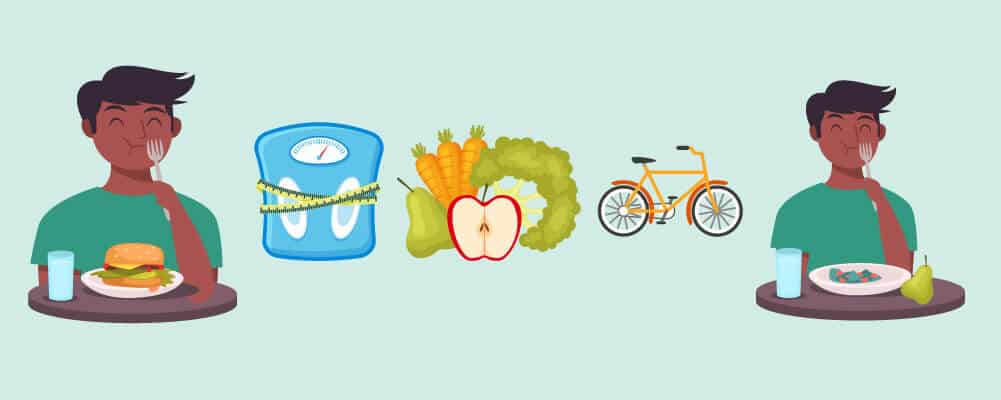Negative Body Image: When to Seek Help?
As adults, we all know that we can become consumed with thoughts about how our bodies compare to others. Now, with the constant stream of … Read more
Updated March 22, 2022 by Leah Alexander, M.D. F.A.A.P.
An eating disorder is a condition in which abnormal eating behaviors have detrimental effects on a child’s health. When most parents hear the phrase “eating disorder,” they think of an adolescent girl who is hospitalized for severe weight loss due to refusing to eat.

However, there is more than one type of eating disorder, and symptoms can begin during early childhood. Both boys and girls can develop them. Children with these conditions present unique challenges for both parents and medical providers.
Several factors distinguish eating disorders from typical childhood picky eating behaviors. Despite consuming a limited diet, picky eaters typically maintain normal weights and growth patterns.
In contrast, children with an eating disorder may experience weight fluctuations, and often suffer from nutritional deficiencies.
Table of Contents

Psychological stress is the most common trigger of childhood eating disorders. Discord or issues at home, school, or other settings become upsetting enough to manifest as problematic eating.
Instead of the more common complaint of headaches or stomach aches, the child responds to stress by altering his or her eating habits.
The role of stress has been further revealed during the CoVID-19 pandemic. The CDC reports that an increased number of children and adolescents have required treatment for eating disorders in emergency rooms since the spring of 2020.
Eight percent of children in the U.S. are allergic to at least one type of food. The initial experience of an allergic reaction can be quite traumatic for a child, especially when it results in a trip to the emergency room.
Afterward, some children become not only afraid of a future allergic reaction, but also change their eating habits. They may refuse to eat at a restaurant, or closely observe food preparation at home to make sure none of the offending food has been added to the meal.
The gold standard of food allergy management is strict avoidance of the allergenic food. However, some children begin to restrict other foods despite no reaction to them. This “fear of food” can progress to anxiety, depression and nutritional deficiencies.
Gastroenteritis, typically known as “stomach virus,” is a common pediatric illness. Vomiting often occurs after an attempt to eat or drink. Although most children are minimally distressed by this, others develop an intense fear of future vomiting.
After the illness has resolved, these children believe that eating will again once trigger symptoms. In mild cases, this fear is situational, for example, a child refusing to eat at school because a vomiting episode occurred there.
In more severe cases, the child refuses to eat select foods because he or she feels they were the cause of illness. Over time, such food restrictions can result in poor weight gain .
Body awareness develops during the early childhood years. Parental opinions of their own bodies, along with societal, peer, and cultural pressures, influence how children view themselves.
The desire to have a certain body type can influence food choices, and the amount a child eats. When body dissatisfaction develops at a young age, it can persist throughout adolescence and adulthood.
The hormone leptin is released into the bloodstream from body fat. Leptin has a direct effect on the hypothalamus in regulating food intake. It also helps the body metabolize fat.
Research shows that leptin levels are altered by a decreased caloric intake which impairs the functioning of the brain’s “satiety center.”
Low leptin levels also promote loss of body fat which can exacerbate unhealthy weight loss in children with some types of eating disorders.

The most common eating disorders include anorexia nervosa, avoidant-restrictive food disorder, bulimia, binge eating disorder, and “other specified” eating and feeding disorder.
A 2019 study of emergency room visits for nine to 10 years olds showed that all five types are possible in kids, but bulimia is less common.
This form of eating disorder is characterized by a purposeful restriction of food intake. Without intervention, it results in progressive weight loss, muscle wasting, and electrolyte imbalances. In cases where a child has an unhealthy body image, there is often a fear of gaining weight.
With this type of eating disorder, children restrict their intake of certain foods due to fear of an adverse reaction.
The child worries that he or she will vomit, choke, or have an allergic reaction if the avoided foods are eaten. As the list of such foods increases, weight loss and nutritional deficiencies become evident.
Children with bulimia eat an excessive amount of food, then compensate for it in some way afterward. Vomiting is the commonly chosen behavior, but older children may instead compensate with more frequent and intense exercise.
There is also an attempt to hide the binging and purging. Bulimia can be more difficult to detect because the child’s weight can be normal or slightly increased.
Although it is less common in children, those with a binge eating disorder feel a compulsion to eat an excessive amount of food over a short period of time.
These children are typically overweight, and at risk for obesity-related medical conditions such as hypertension, diabetes, and high cholesterol.
This classification includes eating disorders that negatively impact health and social functioning, but do not meet the criteria of the other types.

The first sign is often a change a child’s interest in food. Such signs may be evident before any physical symptoms develop. Here are some worrisome behaviors.
This goes beyond typical picky eating behavior. For example, it is normal for a child who has eaten breakfast, lunch, and several snacks throughout the day to have minimal interest in eating dinner.
These children gain weight and grow well. Children with anorexia and avoidant-restrictive food disorders, however, will regularly refuse most of foods offered.
These children will eat a “few bites,” then leave most of the food on their plates. They neither snack nor drink lots of milk and other beverages throughout the day. Weight gain is often suboptimal.
Savvy children with anorexia may use utensils to simulate eating, but don’t actually put much of the food into their mouths. If the family dog is nearby, it may be fed instead of the child.
These children may chew food, then spit it into a napkin to be discarded later. Uneaten school lunches may be brought home and hidden in bedroom drawers or closets. Older children may refuse to eat with the family, requesting to eat separately in order to discard or hide the food.
Children with food allergies may begin to restrict even non-allergenic foods. They may also avoid situations that they believe are a risk for an allergic reaction.
With anorexia or avoidant-restrictive food disorder, children randomly select foods they no longer want to eat. This list of foods increases over time.
Those with bulimia and binge eating disorders may attempt to hide their excessive eating. They may refuse to eat meals with the family in order to avoid comments about the amount of food eaten.
Parents may find evidence of a binge hidden in the child’s room, garbage cans, or other locations.
As disordered eating begins to affect a child’s weight, clothing may no longer fit properly. Children whose eating disorder is associated with an unhealthy body image may choose baggier clothing to hide their appearance.
Over time, the affects on mental and physical health may become evident.
These include:

Because eating disorders include both psychological and physical symptoms, the involvement of a multidisciplinary team is necessary. The initial diagnosis is often made by a pediatrician or primary care provider.
If the child receives care from mental health providers for conditions such as anxiety or depression, they may discover the eating disorder.
Once an eating disorder is suspected, the initial diagnostic work up includes a physical exam, blood work to rule out other medical conditions, and a psychological screening.
Eating disorder management depends on the severity of symptoms at the time of diagnosis. Children who appear dehydrated, have elevated heart rates, or blood pressure fluctuations require stabilization in a hospital setting.
During the hospital stay, they will be evaluated by a psychologist, nutritionist, and any other necessary specialists. Together, this team can address the acute issues, and develop a long-term treatment plan.
Children who are clinically stable can receive outpatient treatment. This involves regular weight checks, psychotherapy, and nutrition management. For children who frequently purge, a dental referral may be necessary.
Unfortunately, some children resist these interventions, making treatment very difficult. Despite these challenges, persistence is important to prevent irreversible effects on growth, bone mineralization, and brain structure.

The first step parents should take is to call their pediatrician or primary care provider. He or she can determine whether or not the child should be assessed in an emergency room or an office setting.
In addition, this provider can assist with referrals to nutritionists, psychologists, and others. Eating disorder treatment centers provide multidisciplinary care in a single location, and offer inpatient and outpatient care options.
Unfortunately, many of have age requirements, and do not offer care to children under the age of 13.

Although having a child with an eating disorder is upsetting and presents treatment challenges, help is available. The most important thing to know is that early recognition and intervention is essential to successful treatment and positive outcomes.
As adults, we all know that we can become consumed with thoughts about how our bodies compare to others. Now, with the constant stream of … Read more
We all want our children to be healthy and happy, but sometimes navigating our children’s food preferences and the time and energy it takes to … Read more
Eating disorders are actually considered psychiatric or psychological conditions. In addition, they are more prevalent in teenager, than in adults. The Diagnostic and Statistical Manual … Read more
Night-eating syndrome (NES), also referred to as night-binging disorder (NBD), is a misunderstood eating disorder that is often linked to the binge-eating disorder (BED) – … Read more
Eating disorders affect people differently, but bulimia is one of the most devastating conditions for your relationship with food in the long-term. This disorder has … Read more
Table of ContentsWhat is Binge-Eating Disorder?Signs and SymptomsPossible Causes of BEDBED Risk FactorsStatisticsSo, What Can You Do?Treatment ConsiderationsMedicationsBehavior Therapies and CounselingOutlookReferences What is Binge-Eating Disorder? … Read more
Approximately 30 million people of all ages and genders suffer from an eating disorder in the U.S. ~ National Association of Anorexia Nervosa and Associated Disorders, … Read more
“Anorexia is the third most common chronic disease among young people, after asthma and Type 1 diabetes.” ~National Eating Disorder Association Written by: Dr Kim … Read more
We all want to do what’s best for our child — after all, we’re their ultimate support system and role model. Our actions during their … Read more